|
The Search for Earthlike Atmospheres
|
|
| DoctorOfSpace | Date: Sunday, 20.11.2016, 15:24 | Message # 61 |
 Galaxy Architect
Group: Global Moderators
 Pirate
Pirate
Messages: 3600
Status: Offline
| Dead fairly quickly, but you could have a face mask, like the one in Avatar, and that would let you walk around relatively safely.

Considering how rare an Earth match seems such planets would probably be preferable for humanity, in the current SE universe, as they could be terraformed.
Intel Core i7-5820K 4.2GHz 6-Core Processor
G.Skill Ripjaws V Series 32GB (4 x 8GB) DDR4-2400 Memory
EVGA GTX 980 Ti SC 6GB
|
| |
| |
| catyak2005 | Date: Tuesday, 22.11.2016, 02:30 | Message # 62 |
 Observer
Group: Users
 Pirate
Pirate
Messages: 17
Status: Offline
| High Oxygen content, but probably too low air pressure. Effective temp is 56°F.
The lowest I've heard you could survive (with 100% Oxygen) is around .12atm
The Armstrong Limit (where you blood boils at room temp) is 0.0618atm

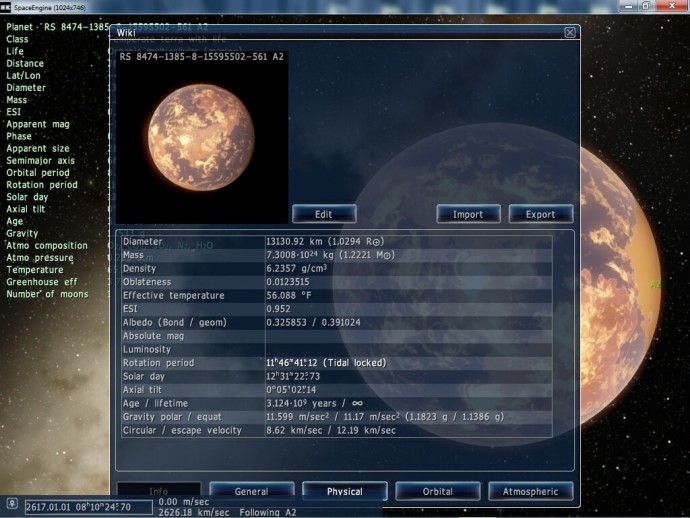
|
| |
| |
| catyak2005 | Date: Tuesday, 22.11.2016, 04:18 | Message # 63 |
 Observer
Group: Users
 Pirate
Pirate
Messages: 17
Status: Offline
| 68% Oxygen at 1.24atm, 1.5968G, Temperate Terra with unicellular marine life
12 and a half hours rotation but seems to be tidally locked to its host star.
It has the orbit similar to a moon of Jupiter that has ignited.
edit: Sulfur Dioxide condenses at 14°F at normal pressure, under higher pressure on this planet (1.8 atm) it would snow at around 28°F. Effective temp here is -10°F (-23°C). So, dress warmly and stay away from the stinky smells!
Boiling point for pressure calculator
http://www.trimen.pl/witek/calculators/wrzenie.html
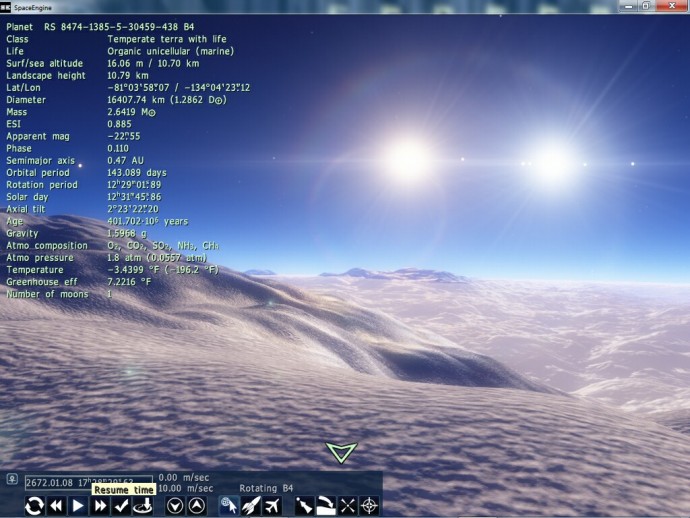

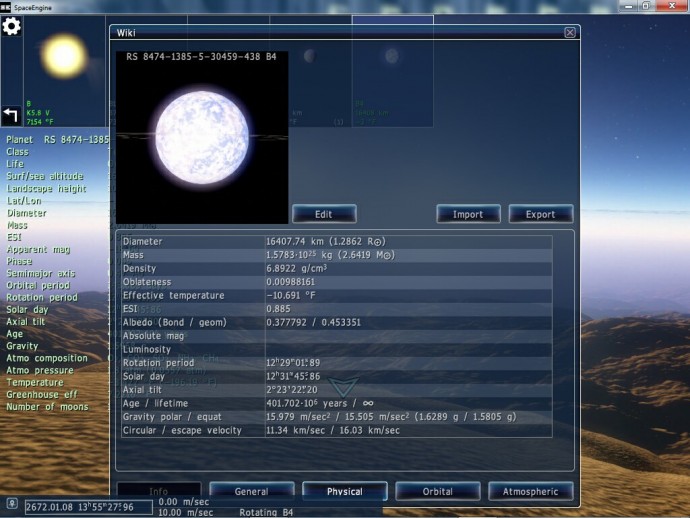
Edited by catyak2005 - Tuesday, 22.11.2016, 05:10 |
| |
| |
| Matsoftware | Date: Thursday, 24.11.2016, 13:54 | Message # 64 |
|
Space Pilot
Group: Users
 Hungary
Hungary
Messages: 86
Status: Offline
| Quote catyak2005 (  ) High Oxygen content, but probably too low air pressure
The planet's surface atmosphere pressure is ~0.3 atm (earth atmosphere pressure)[DOT]
Elements of atmosphere: ~96% Oxygen, 5.02% Carbon-Dioxide, 1.05% Nitrogen, 1.01% Sulfure-Dioxide
Screenshot:

My mods
If I'm not replying to a PM, my account is hacked!
Edited by Matsoftware - Thursday, 24.11.2016, 13:56 |
| |
| |
| Ostarisk | Date: Thursday, 24.11.2016, 22:16 | Message # 65 |
 Pioneer
Group: Users
 Australia
Australia
Messages: 451
Status: Offline
| Matsoftware, Not good. Even though we breathe oxygen, the atmosphere is still unbreathable for many reasons. For starters, the oxygen levels are too high, and there is not enough nitrogen (Nitrogen should make up most of the atmosphere) and there is too much carbon dioxide and sulfur in the atmosphere.

My mods
|
| |
| |
| Watsisname | Date: Friday, 25.11.2016, 04:27 | Message # 66 |
 Galaxy Architect
Group: Global Moderators
 United States
United States
Messages: 2613
Status: Offline
| The total pressure is only 0.3atm though, so the amount of oxygen and CO2 are actually fine for us (remember it's the partial pressure that matters, not the percentage of the air). We also don't require nitrogen to breathe (it's important for the nitrogen cycle on Earth, but for our breathing it's just an inert gas and doesn't matter). The one thing that is a problem is the SO2, as usual.
Well, I guess the surface gravity is also a little high, but overall the planet looks great. 

|
| |
| |
| DoctorOfSpace | Date: Friday, 25.11.2016, 05:23 | Message # 67 |
 Galaxy Architect
Group: Global Moderators
 Pirate
Pirate
Messages: 3600
Status: Offline
| Quote Watsisname (  ) the surface gravity is also a little high
1.5 is well within tolerance range for humans, it would be a bit uncomfortable for a little while on the average person. I think the average astronaut or fighter pilot could probably tolerate it just fine.
Quote Watsisname (  ) The one thing that is a problem is the SO2, as usual.
A breathing mask, like the one posted above, would probably be enough to survive it. Considering the levels and atmospheric pressure you may only need a filter over your mouth/nose, though it would probably be bad for the eyes still.
Intel Core i7-5820K 4.2GHz 6-Core Processor
G.Skill Ripjaws V Series 32GB (4 x 8GB) DDR4-2400 Memory
EVGA GTX 980 Ti SC 6GB
|
| |
| |
| catyak2005 | Date: Friday, 25.11.2016, 07:55 | Message # 68 |
 Observer
Group: Users
 Pirate
Pirate
Messages: 17
Status: Offline
| Yeah, pretty nice and only 41 light years away from Sol.
I found that one two months ago and was initially surprised by the amount of O2
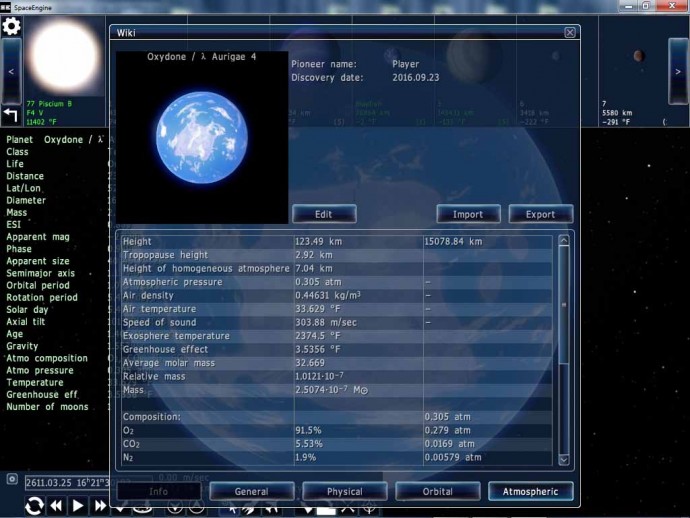
|
| |
| |
|
| catyak2005 | Date: Monday, 28.11.2016, 00:50 | Message # 70 |
 Observer
Group: Users
 Pirate
Pirate
Messages: 17
Status: Offline
| HIP 51603 4 (Frosty)
Temperate terra with unicellular marine life
ESI .877
Nearly tidally locked, but not.
Axial Tilt: 39°56'14"
Gravity 1.27G
Oxygen 68.3% @ 1.09atm
Carbon Dioxide 18% @ .288atm
Sulfur Dioxide 13.3% @ .213atm
Effective temp: -1.5°F
A frosty place to be indeed. You might be able to run around naked and probably not get tired so easily with this much O2. I do realize 10% of the air being CO2 will kill you here on Earth, but at the atm noted for this planet, I'm not so sure. I don't know the formula for calculating this. I would check with the computer's atmosphere analysis before stepping outside naked though.


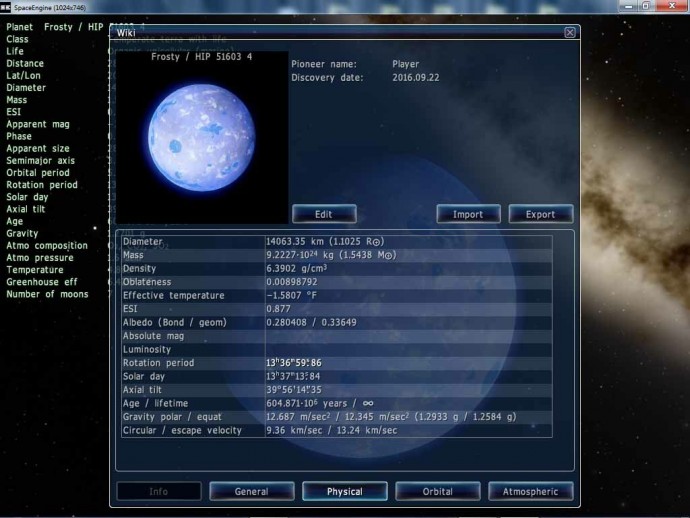
|
| |
| |
| Watsisname | Date: Monday, 28.11.2016, 02:20 | Message # 71 |
 Galaxy Architect
Group: Global Moderators
 United States
United States
Messages: 2613
Status: Offline
| Quote catyak2005 (  ) I do realize 10% of the air being CO2 will kill you here on Earth, but at the atm noted for this planet, I'm not so sure. I don't know the formula for calculating this.
The CO2 on that planet would kill very quickly. To figure out how to determine breathability, see the chart and description which is about halfway down in the thread's opening post. Also in the following post, Doctor of Space has a nice image for the effects of exposure to different O2 concentration or temperature.
This info is still incomplete in that there are gases which have not been added yet, like CH4.

|
| |
| |
| catyak2005 | Date: Monday, 28.11.2016, 04:04 | Message # 72 |
 Observer
Group: Users
 Pirate
Pirate
Messages: 17
Status: Offline
| OK thanks! I guess I'll read more next time. Love the survival chart.
I see now in my example how carbon dioxide makes up 18% of 1.6 atm giving .288 atm pressure or molecules in the air.
That means it would be equal to .4608 atm at 1 atm total air pressure, or equal to 46% of the atmosphere here on Earth being CO2, or ten times what we have on Earth (4% ) .
Where X is the equivalent air pressure on Earth.
x=.288/(1/1.6)
I guess.
Edit:
In medical science 1 atmosphere, the pressure of the air at the sea level, is expressed as 760 millimetres of Mercury, or 760 mm Hg
When it comes to CO2, its concentration in the blood, after the blood has collected all the CO2 generated by the bio-chemical process keeping the cells alive reaches the pressure of 45 mm Hg, while the pressure inside the lungs after we breathe in the air is 0.3 mm Hg.
Earth CO2: (0.04/100)*760 = 0.3 mm Hg
Therefore, as long as the partial pressure of CO2 in the air that we breathe in is less than 45 mm Hg, the human body will be able to clear out the cell-produced CO2.
Max CO2: (X/100)*760 = 45 mm Hg = 6% or 60,000 PPM
@ 2,000-5,000 ppm Headaches, sleepiness and stagnant, stale, stuffy air. Poor concentration, loss of attention, increased heart rate and slight nausea may also be present).
CO2 in my example: (46.08/100)*760 = 350 mm Hg
So nearly 8 times what is survivable for Humans.
Edited by catyak2005 - Monday, 28.11.2016, 04:25 |
| |
| |
| Watsisname | Date: Monday, 28.11.2016, 05:44 | Message # 73 |
 Galaxy Architect
Group: Global Moderators
 United States
United States
Messages: 2613
Status: Offline
| Quote catyak2005 (  ) I see now in my example how carbon dioxide makes up 18% of 1.6 atm giving .288 atm pressure or molecules in the air.
Right. 
Quote catyak2005 (  ) That means it would be equal to .4608 atm at 1 atm total air pressure, or equal to 46% of the atmosphere here on Earth being CO2, or ten times what we have on Earth (4% )
No, this is like having 28.8% of the air on Earth being CO2. 0.288atm of CO2 at 1.6atm of total pressure is 0.288atm of CO2 at any other total pressure. (Though of course the total pressure must be at least the partial pressure).
Also, CO2 on Earth currently makes up 400 parts per million. That's 0.04% of the air, or 0.0004atm partial pressure CO2. So this planet has 720 times the CO2 that Earth does.
The math in your edit looks good. It's a few times more than what humans can handle (hard to say exactly since the survivable limit is fuzzy and depends on the individual and exposure time.)

|
| |
| |
| DoctorOfSpace | Date: Monday, 28.11.2016, 20:49 | Message # 74 |
 Galaxy Architect
Group: Global Moderators
 Pirate
Pirate
Messages: 3600
Status: Offline
| I have been trying to figure out a scale system for SE for a while now regarding planetary habitability. There seem to be too many variables to just say something is safe or something is deadly.
Initially I was thinking of an icon system, a smiley face for safe, skull for dead, but that doesn't include other aspects such as limited exposure, masks, or environmental suits.
Maybe if we all work out a system we could get a human survival scale built into SE.
Intel Core i7-5820K 4.2GHz 6-Core Processor
G.Skill Ripjaws V Series 32GB (4 x 8GB) DDR4-2400 Memory
EVGA GTX 980 Ti SC 6GB
|
| |
| |
| Ostarisk | Date: Monday, 28.11.2016, 22:00 | Message # 75 |
 Pioneer
Group: Users
 Australia
Australia
Messages: 451
Status: Offline
| Quote DoctorOfSpace (  ) Maybe if we all work out a system we could get a human survival scale built into SE.
I was thinking of a gas mask or oxygen tank for a livable planet with unbreathable atmosphere, and a neutral face for limited exposure.
and if it somehow happens anytime soon, use an anvil with a smiley face on it for a breathable atmosphere with too much air pressure.

My mods
Edited by Ostarisk - Monday, 28.11.2016, 22:00 |
| |
| |